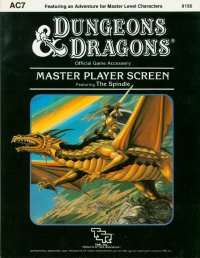Master Player Screen

Master Player Screen featuring The Spindle is a short accessory designed for the Pen & Paper role-playing game Dungeons & Dragons.
Contents
It features a Dungeon Master screen designed for characters from the Basic through Master sets, which collects the most important tables for characters from those sets.[1] This product also included a mini-scenario titled The Spindle of Heaven.[1]
Screen
The new screen includes hit rolls, saving throws, thief abilities, experience tables for all classes, turning table for clerics, and a spell list for magic users and clerics. It folded out into four sections to hide the Gamemaster's dice roll and prepared work from the players.
The Spindle
The Spindle of Heaven adventure is a short but difficult module for extremely high level characters between 26th and 36th level.
In it the group goes to the great mountain, the Spindle of Heaven, and finds a clue to the secret to immortality. The adventure is just an introduction that leads to a long campaign left up to each individual gamemaster.
Plot summary
The group starts in the village of Nareeb where they hear various rumors about the mysterious spindle. The group travels across the desert battling vicious creatures to reach the Spindle of Heaven.
The group climbs the great mountain and fights creatures sent by the ruler of the region every step of the way.
Eventually the group reaches in the inner sanctum of the main boss and a terrifically high level battle begins. Once the group subdues the Master of the Spindle they can gain information about immortality or any other quest current to the particular campaign.
Enemies
- Airdrake
- Black Pudding
- Djinni, Lesser
- Druj
- Elemental, Air
- Giant, Cloud
- Gray ooze
- Hobgoblin
- Invisible stalker
- Manscorpion
- Rust monster
- Scorpion, Gargantuan
- Sphinx
- Vampire
Publication history
AC7 Master Player Screen Featuring the Spindle was designed by Bruce Nesmith, with a cover by Larry Elmore, and was published by TSR in 1985 as a cardstock screen with an 8-page pamphlet.[1]
References
- 1 2 3 Schick, Lawrence (1991). Heroic Worlds. Buffalo: Prometheus Books. p. 134. ISBN 0-87975-653-5.